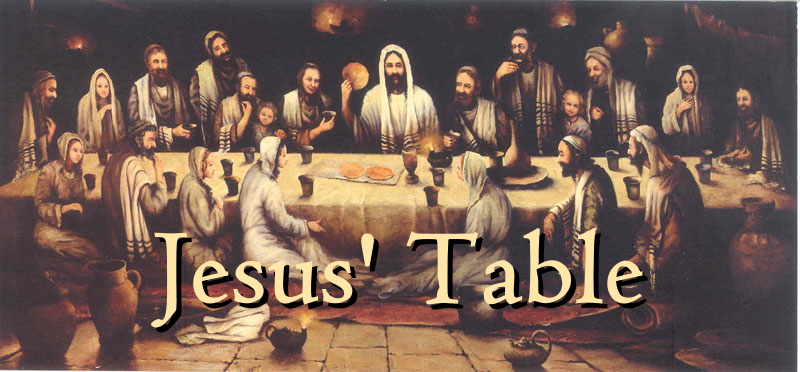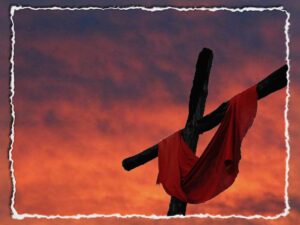A congregation of the United Church of Canada

Yr B ~ Creation 3 ~ Mark 14:17-24

Scripture always says it like this: Mark 14:17-18 (On the day of Passover) when it was evening, Jesus came with the twelve (and they) reclined at the table and were eating…
It makes it sound like it was just the 13 men gathered. But if this is their Passover gathering – and it says clearly that it was – then their families would be present too. That expansive sense of gathering at Jesus’ table is very important, and has been since the beginning.
About the only thing I dislike about the picture is that the only stuff on the table is some flatbread and everyone’s drinking glass. Scripture also clearly says that the celebration of what we now call Communion wasn’t a specialized, separate thing. It emerged in the midst of their meal.
Mark 14:22-24 While they were eating, Jesus took a loaf of bread (of course it wasn’t a ‘loaf’ like we have here – it was unleavened, so it was flatbread – and if it was a Passover meal then it would’ve been matzah bread which is flat and firm, almost like a giant cracker). So Jesus took the bread and after blessing it he broke it, gave it to (all the people gathered), and said, “Take; this is my body.” Then he took a cup, and after giving thanks he gave it to them, and all of them drank from it. He said to them, “This is my blood of the covenant, which is poured out for many.”
Shared bread and a common cup that they all drank from. I don’t know about you but here in the midst of a world-wide pandemic when we can’t even be in the same room together the idea of sharing a common cup sends chills down my spine! And yet I love the idea of it. A common cup – a shared experience.
We commemorate that night, that meal, through a ritual that at Faith United we rehearse on the first Sunday of every month. We call it Communion. Other churches may call it Eucharist, which means thanksgiving. It’s also called the Lord’s Supper. And today, the first Sunday in October, churches around the world make a point of celebrating Communion on the same day, which we’ve called World Communion Sunday.
Think about that.
Churches all over the world – the body of Christ in all its myriad, wildly different forms – making a point of making this expression of unity and oneness. There are well over 20,000 different denominations within Christianity, and not all of them celebrate Communion, and not all of them observe World Communion Sunday, but that it even exists is a remarkable thing to me. Especially since the theology around Communion is one of the main things that has split churches and created new denominations over time.
Dividing over Communion. Oh the irony!
Communion is one of our two sacraments, along with baptism. A sacrament by definition is ‘a visible means of an invisible grace.’ In other words, it’s something that communicates God’s grace (which cannot be seen) through something we can see and touch – the water, the bread, the wine. But there’s nothing magical about bread and wine, they’re just symbolic. The point is that these ordinary, tangible things convey God’s extraordinary grace and blessing.
Sometimes I jokingly refer to the small cube of Communion bread and the tiny glass of juice as ‘a shot and a crouton’. We refer to it as a feast, but how can anybody call a shot and a crouton a feast? But it is!
That little crouton, that tiny cube of bread, that puny fragment of the whole represents and symbolizes the very stuff of God that gives life, strength, and vitality, and meaning, and purpose.
That miniscule crumb has the power to utterly transform and renew your life and my life – and not just once a month when we share in Communion together, but each and every day with each and every bite of ‘bread’ that we eat.
Jesus said, “This is my body – eat. This is my blood – drink. Remember.”
Some folks have trouble with that ‘body and blood’ language. No, we’re not cannibals and vampires. ‘Body and blood’ are just metaphors. Very deep and powerful metaphors!
I simply think of them as the body symbolizing the strength of Jesus, of being his hands in the world – and the blood as being his life-blood, his passion, his energy, his spirit, of being his heart in the world.
And my sense of communion is never limited to what we put on this table and serve up once a month. Communion happens every time I eat and drink.
At least it can – if I do what he said – remember.
I can be refilled and renewed with Jesus’ strength and Jesus’ passion – if I do what he said – remember.
Every time we eat and drink can be a sacrament, if we notice.
His name was George. He was almost 50 when we met him. He was a member of the church I served in Nova Scotia. George was a special guy – he had the kinds of developmental challenges that usually mean you don’t live to be a teenager. One of his favourite lines was “he’s my friend”. After he met you whenever someone would come up and talk to you George would say “he’s my friend”. He absolutely lit up every room he ever walked into. George was indeed a special guy.
At that church we served Communion on trays that were passed along the pews while people remained seated. We’d pass out all the bread and then we’d say some words and partake together, then we’d do the same for the juice. I’m not a big fan of that method, but I do like that there is a sense of oneness when the whole congregation eats and drinks at the same moment. Anyway, one day George was there, and in that hushed, reverent silence that hangs over the sanctuary during Communion as the bread was making its rounds, one familiar voice loudly rang out, “That’s good bread!”
It was a totally innocent and unplanned comment, but it was one of the most profoundly spiritual things I’d ever heard. My heart nearly burst, and I couldn’t stop smiling. That’s good bread! It wasn’t particularly good, of course. It was probably a cheap loaf of store bought white bread, cut into a little cube. But in Communion, and especially with George’s impromptu 3-word sermon, that bland bit of bread became the holiest Communion bread I’d ever eaten. He just couldn’t wait for the rest of us – he had to eat it right away! And that little tiny taste was enough to provoke a deep, heartfelt reaction in him. It was special bread – it was Communion bread – it was the bread of heaven – it was the stuff of God.
George’s bread story has endured through the years in my family. Whenever we have fresh-baked bread at home someone invariably comments “that’s good bread” – not because we’re mocking George, in fact, it’s exactly the opposite. Whenever we taste fresh bread and enjoy it we call out “that’s good bread,” and we remember that story, and the simple loaf becomes Communion all over again. And not only are we giving thanks for what we’re eating but it also connects us to George, and to that church, and to God. What a gift!
That story is probably my most memorable Communion.
What about you?
What are your fondest memories of Communion?
Do you have one or two that stick out in your mind? I hope you’ll share those stories with one another.
I asked some folks why Communion was important to them. They said things like: it grounds you, it’s something tangible in an otherwise abstract faith, it’s an affirmation of your faith, it renews you.
Comm-union – with union – union with Christ – union with God – union with the Holy Spirit –union with one another as we share in the meal.
But also from the Latin word communio which means ‘mutual participation’ – again, mutual participation with Christ, with God, with the Holy Spirit, with one another.
When you eat the bread and drink the wine/juice, what happens for you?
How does it make you feel?
What goes through your mind?
What stirs in your spirit?
When the bread touches your tongue do you think of Jesus? Does it give you strength?
When the liquid touches your lips do you get a sense of transformation? Of the Holy Spirit infusing you with purpose, and passion, and love?
Is Communion a spiritual experience for you, or just another empty ritual? If I’m being really honest, it depends on the day. But, you know, even on bad days, once I get immersed in the sacrament – catch the rhythm of the language – and pause in that glorious, sacred moment immediately after I’ve eaten and drank – in that moment it is always a spiritual experience for me. It moves me very deeply.
Once upon a time, in our denomination, you had to be a full member of the church to receive Communion. And some of you out there will even remember being visited by an elder of the church just before one of the four Communion Sundays in a year, and you got a ‘Communion card’ that allowed you to receive the sacrament. That certainly elevates the esteem in which Communion is held, but it comes at a terrible and unloving cost. It excludes. It stops some people from coming to Jesus’ table. That sounds revolting to me. I’m so glad our collective theology of Communion has evolved over the years.
Now we celebrate a radically open table for Communion. That feels a lot more like Jesus to me!
There was a time when children weren’t allowed to have Communion. Again, that just feels so wrong to me. The argument was that they couldn’t understand what they were doing. Well, friends, if that’s the bar then do I get to administer a theology quiz to all the adults who line up at the table to make sure everyone gets the right answers before they’re served? The very thought of it makes me squirm.
I find it fascinating that this Covid pandemic has forced us to rethink a bunch of our theology yet again.
We are not physically together, but we still do Communion together each month. I stand at Jesus’ table, and break bread and pour ‘wine’, and bless the holy elements.
But you can’t come to this table. You have to create your own table – and your own elements.
You could be having chocolate chip cookies and a coffee as your body and blood for all I know. And that’s perfectly fine by me. You know what I say every time – as long as you prepared your elements with the intention of them being holy, and sacred, and blessed, then they are!
Of course, I wish we were together.
But this extended table of Jesus, that reaches out beyond the confines of the bricks and mortar of this place, and connects us together wherever we may be – that renewed and expanded theological understanding is a wonderful gift.
This extended table connects us all.
And on World Communion Sunday this table connects us to Jesus-people everywhere.
Jesus’ table has no bounds – no end – no limits.
Jesus’ table excludes no one.
Jesus’ table is a place around which we gather together – to eat and drink – to be fed with spiritual food – to be strengthened and empowered to be Christ’s hands and heart in the world.
All are welcome at his table.
Come. Eat. Drink. Remember.
Be filled with the fullness of Christ, and go into the world, and love.
Amen.
[after this sermon we sang ‘The Table’ by Chris Tomlin]



